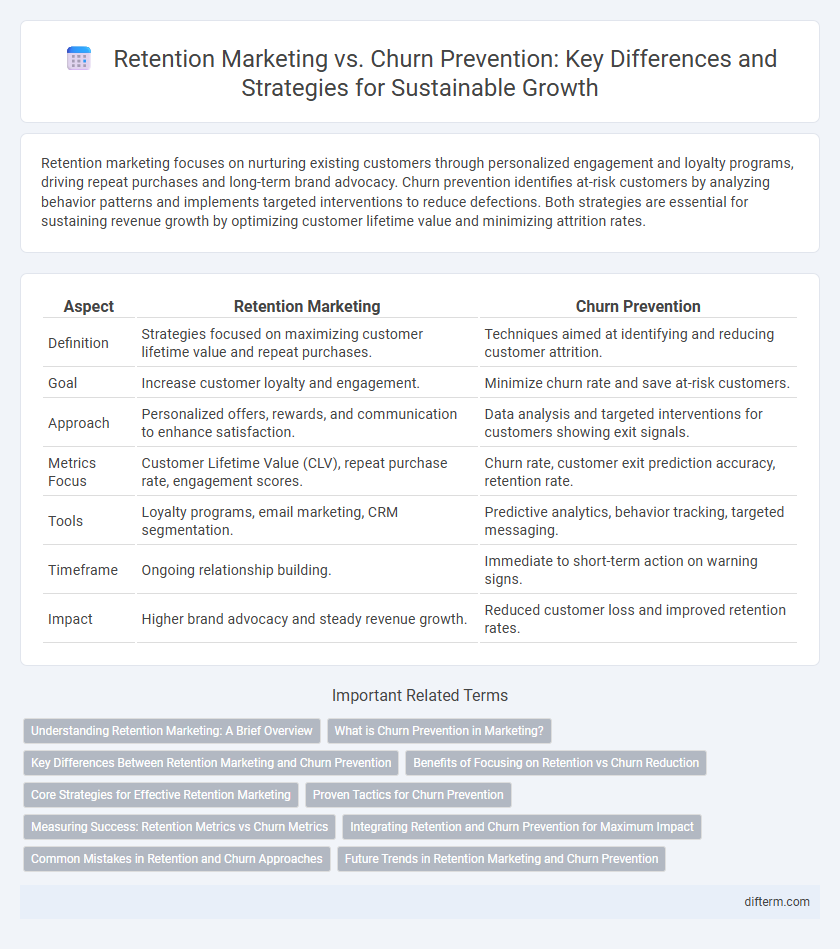Retention marketing focuses on nurturing existing customers through personalized engagement and loyalty programs, driving repeat purchases and long-term brand advocacy. Churn prevention identifies at-risk customers by analyzing behavior patterns and implements targeted interventions to reduce defections. Both strategies are essential for sustaining revenue growth by optimizing customer lifetime value and minimizing attrition rates.
Table of Comparison
| Aspect | Retention Marketing | Churn Prevention |
|---|---|---|
| Definition | Strategies focused on maximizing customer lifetime value and repeat purchases. | Techniques aimed at identifying and reducing customer attrition. |
| Goal | Increase customer loyalty and engagement. | Minimize churn rate and save at-risk customers. |
| Approach | Personalized offers, rewards, and communication to enhance satisfaction. | Data analysis and targeted interventions for customers showing exit signals. |
| Metrics Focus | Customer Lifetime Value (CLV), repeat purchase rate, engagement scores. | Churn rate, customer exit prediction accuracy, retention rate. |
| Tools | Loyalty programs, email marketing, CRM segmentation. | Predictive analytics, behavior tracking, targeted messaging. |
| Timeframe | Ongoing relationship building. | Immediate to short-term action on warning signs. |
| Impact | Higher brand advocacy and steady revenue growth. | Reduced customer loss and improved retention rates. |
Understanding Retention Marketing: A Brief Overview
Retention marketing focuses on nurturing existing customers through personalized engagement, loyalty programs, and targeted communication to increase their lifetime value. It emphasizes building strong customer relationships and delivering consistent value to encourage repeat purchases and brand advocacy. Unlike churn prevention, which primarily aims to identify and stop customers from leaving, retention marketing proactively creates positive experiences to sustain long-term loyalty.
What is Churn Prevention in Marketing?
Churn prevention in marketing involves strategies designed to identify and retain customers at risk of leaving a brand or service, thereby minimizing customer attrition. Techniques such as personalized communication, loyalty programs, and predictive analytics are employed to proactively address dissatisfaction and enhance customer engagement. Effective churn prevention directly impacts revenue stability by maintaining a consistent customer base and reducing the costs associated with acquiring new customers.
Key Differences Between Retention Marketing and Churn Prevention
Retention marketing focuses on engaging and nurturing existing customers to increase their lifetime value and encourage repeat purchases, using personalized campaigns and loyalty programs. Churn prevention specifically targets at-risk customers, aiming to identify warning signs and implement strategies like targeted offers or improved customer support to stop them from leaving. The key difference lies in retention marketing's broad approach to growth through continuous engagement versus churn prevention's reactive focus on mitigating customer loss.
Benefits of Focusing on Retention vs Churn Reduction
Focusing on retention marketing drives long-term customer loyalty by enhancing lifetime value and fostering brand advocates, which leads to sustainable revenue growth. Retention strategies optimize marketing spend by targeting engaged customers more likely to repurchase, reducing acquisition costs compared to churn prevention efforts. Prioritizing retention over churn reduction allows businesses to build deeper customer relationships that generate higher returns through consistent engagement and satisfaction.
Core Strategies for Effective Retention Marketing
Retention marketing centers on building long-term customer engagement through personalized communication, loyalty programs, and consistent value delivery. Core strategies include leveraging customer data analytics for tailored offers, optimizing customer experience across multiple channels, and implementing feedback loops to address pain points proactively. These tactics not only enhance customer lifetime value but also reduce churn by fostering brand affinity and trust.
Proven Tactics for Churn Prevention
Proven tactics for churn prevention include personalized communication, leveraging predictive analytics to identify at-risk customers, and implementing loyalty programs that reward ongoing engagement. Employing data-driven segmentation enables marketers to tailor retention efforts precisely, improving customer lifetime value and reducing attrition. Continuous feedback loops and proactive customer support also play critical roles in minimizing churn rates effectively.
Measuring Success: Retention Metrics vs Churn Metrics
Measuring success in retention marketing centers on metrics such as Customer Lifetime Value (CLV), Repeat Purchase Rate, and Cohort Retention Rate, which indicate sustained engagement and loyalty. In contrast, churn prevention relies on tracking Churn Rate, Customer Attrition Rate, and Win-Back Rate to identify and reduce the loss of customers over time. Both approaches require analyzing customer behavior data to optimize marketing strategies and improve overall profitability.
Integrating Retention and Churn Prevention for Maximum Impact
Integrating retention marketing and churn prevention strategies maximizes customer lifetime value by simultaneously enhancing engagement and reducing attrition rates. Utilizing data-driven insights to personalize communication and deliver targeted offers strengthens customer loyalty while identifying at-risk segments for proactive intervention. This holistic approach ensures sustained revenue growth through balanced efforts that both retain existing customers and minimize churn effectively.
Common Mistakes in Retention and Churn Approaches
Common mistakes in retention marketing include neglecting personalized communication and failing to analyze customer behavior accurately, which leads to generic campaigns that don't engage users effectively. In churn prevention, businesses often misuse reactive strategies instead of proactive engagement, overlooking early signs of customer dissatisfaction and missing opportunities to intervene. Both approaches suffer when companies do not integrate data-driven insights, resulting in ineffective targeting and diminished customer lifetime value.
Future Trends in Retention Marketing and Churn Prevention
Retention marketing leverages predictive analytics and AI-driven personalization to anticipate customer needs, enhancing loyalty and lifetime value while reducing churn rates. Emerging trends emphasize seamless omnichannel experiences and real-time engagement through advanced CRM platforms to foster deeper customer relationships. Integration of behavioral data and machine learning algorithms is transforming churn prevention strategies by enabling proactive, tailored interventions before customer attrition occurs.
Retention marketing vs Churn prevention Infographic

 difterm.com
difterm.com